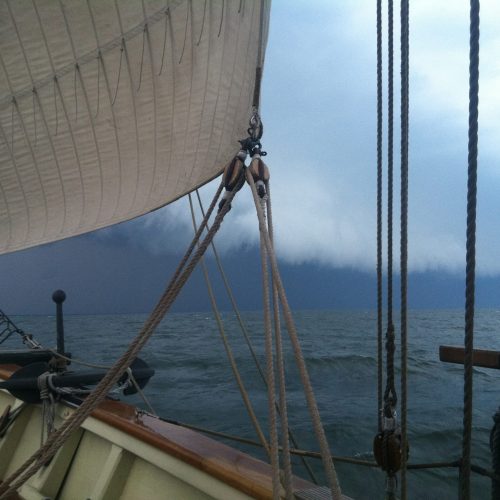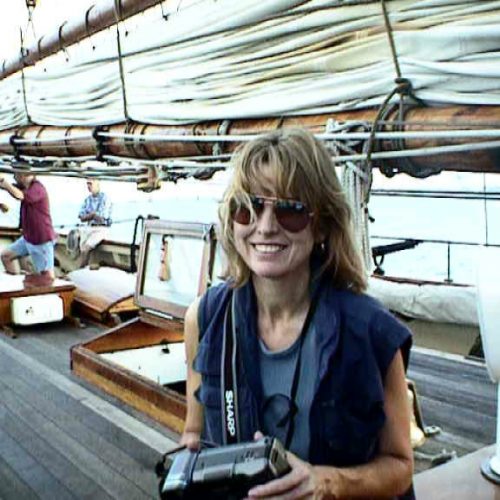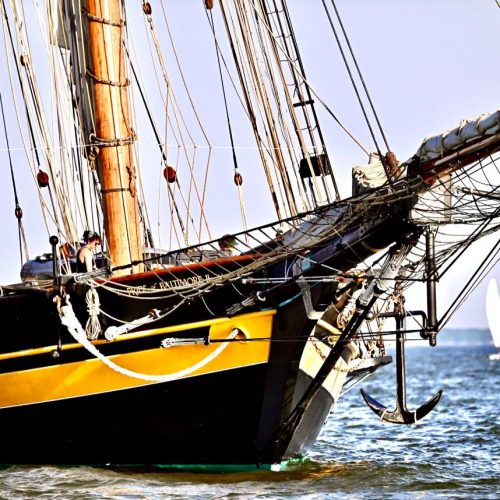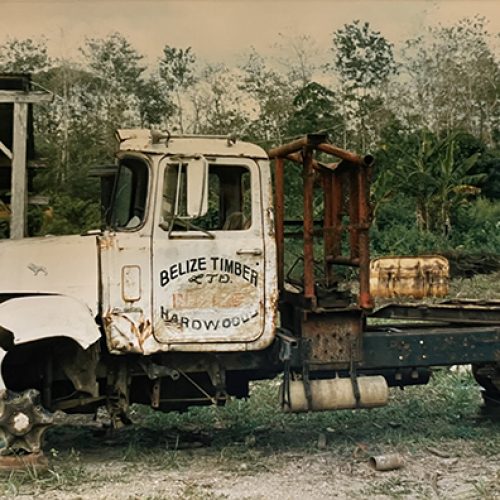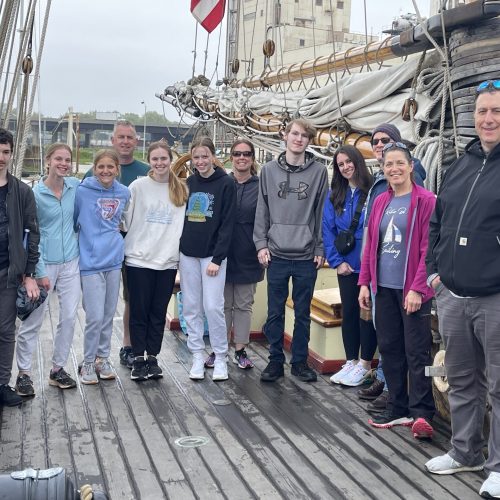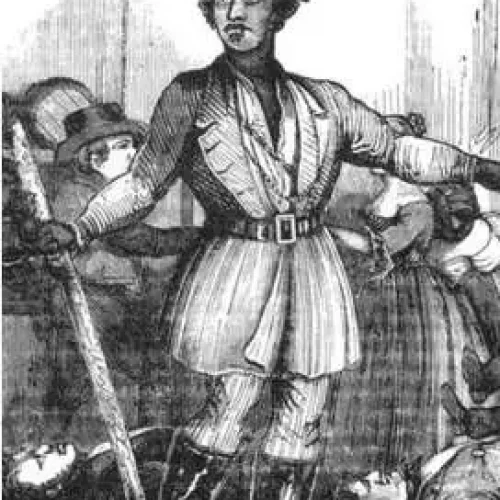18 August 2010
Alongside in Port Washington, Wisconsin
Wind SW F1
Pride of Baltimore II is in early to Port Washington, Wisconsin, a quiet little harbor town just North of Milwaukee, after completing Race 4 of the Great Lakes Tallships Challenge. Between the finish line and here, the crew were also able to complete their Great Lakes Swim Call Challenge when the breeze died. They have now swum in all five Great Lakes.
All this was possible due to a fast finish in the race – 118 nautical miles in 18 hours and 15 minutes for an average speed of 6.5 knots. Not rocket speed for Pride II, but better than the drifting conditions of Races 1 or 2. By comparison, Race 2 was roughly the same length, 121 nautical miles, and took us over 30 hours to finish.
This race featured the largest fleet yet, and there was one start for both classes. The War of 1812 was well represented by the Brig Niagara, Pride II, Lynx and the Tops’l Sloop Friends Good Will, out of South Haven, Michigan. There are only five 1812 replicas sailing in the United States, so to have four at one starting line was spectacular.
Due to some irritating difficulties with a flag stuck in a Fore Tops’l reef tackle block, Pride II had a poor start – but so did the rest of the fleet. We all seemed to cross in one big pack roughly four minutes after the gun. Even Denis Sullivan and Lynx, whose captains have been pretty sharp on the line this whole series, were late.
After the start, the drag race started. With the wind just half a point forward of the beam, all the boats quickly established a pecking order based on waterline length. Pride II was at the leeward end of the line, where I though we’d have clearer air. Niagara, under relatively conservative canvas, was off to leeward and slightly ahead. She started making moves to press Pride II to weather, using their rights as the leeward vessel. This would have meant closing with the shoreline and getting into the dirty air of the rest of the fleet to weather. Making better speed under more sail, we ducked beneath her and sailed through her lee.
The race between Niagara and Pride II is always an interesting one. On corrected time, it is nearly a boat for boat race, with Pride II needing to be ahead by a scant 18 seconds per every hour raced. And while both vessels are sleek, attractive War of 1812 replicas, they are about as different can be. Niagara is a shoal drafted Brig with tremendous sail area – 2,000 square feet more than Pride II. Her namesake was designed for the shallow waters of Lake Erie, and to be sailed with a large military crew than could disassemble the rig to reduce windage and weight aloft in heavy weather. Pride II is deeper, with less sail and sail area concentrated in few sails.
The conditions often dictate how the race between the two boats is won. If the wind is on the beam or further behind and less than 15-20 knots, Niagara usually wins the day. In stronger or more weatherly conditions, Pride II often prevails. At the start, 10-15 knots on about the beam, it was still Niagara’s race. Just after we passed her, she shook out reefs and set royals, quickly coming up and then slowly overtaking us. As the breeze built and faded through the afternoon, we would rage up on her in the puffs, then drop back in the lulls.
A reaching race, while fun to sail, is often fairly boring in terms of tactics. All the boats point toward the finish, carry as much sail as they dare and usually finish predictably in order of waterline length. Variations in the breeze can determine the winners and losers – if it fills in late in the race, the smaller boats benefit, but they lose out if it fades after the larger boats finish. Consistency in weather, however, is not something the Great Lakes are known for, and the forecast for this race included a backing breeze. At some point, the wind was going to come ahead, but when exactly couldn’t be known. The sooner it happened, the better for Pride II, as she is among the best in the fleet for upwind sailing. The strategy was in how to set up for the shift.
In anticipation of the wind shift, I knew pointing higher than the rhumbline – that straight distance to the finish – was the best strategy, even though it meant more miles sailed. If we were upwind of the rhumbline, it would mean not having to tack, or at least not tack as much, when the wind came ahead. How far above was the issue. Closing with the Wisconsin shoreline too much meant a potential for less wind in the lee of the land, so I set us on a course with the wind just forward of the beam, so we could still carry the stuns’l to try for a bit more speed.
With the stuns’l just on the verge of collapsing and the deck edge occasionally getting wet, we had some of the most exciting sailing of the season aboard Pride II, topping out at 9.7 knots in 20 knots of true breeze. The rest of the fleet started to fade behind us, all but the modern racing yacht Fazizi – who would need to finish in half the time as Pride II in order to beat us on corrected time – and Niagara.
Except for one instance in which we made Captain Wesley Heerrssen a bit jumpy by suddenly falling off to keep the stuns’l full, we slowly drifted west and to weather of Niagara. While this was my strategy, I began to wonder if Niagara, sailing roughly the rhumbline yet actually able to point higher, was on to something I wasn’t. A check of the most current weather forecast gave me even greater concern. While the overall picture was for the breeze to keep backing and eventually come due south, there was suddenly an evening forecast of easterly winds. How were we to set up for that? A shift to the east could put us flat aback or get us turned in totally the wrong direction. As we approached Sheboygan Point, Wisconsin, the proudest headland before the shore curved in the west, there was much to mull over.
I decided ten miles off Sheboygan Point was the closest we should get. This marked roughly the halfway point of the race. By the time she drew abeam of it Pride II was more to weather than anyone else in the fleet. But Niagara was still ahead and still on the rhumbline. The wind was already beginning to back, and so I elected to alter course with it to keep holding onto the stuns’l and start slowly closing with the finish line, aiming just for the West end of it.
With this strategy, we were also slowly converging with Niagara, who was slowing down due to the wind shift. But our instruments indicated hours to go before we would intercept them, if at all. I had the sensation of being torn by two totally separate races – one against Niagara (boat for boat) and one against the rest of the B, C & D fleet, none of whom had reached the decision making point at Sheboygan.
Nightfall saw the wind go southwest and fade. We hardened up and took in the stuns’l. The wind was anything but steady, and our course was alternately laying the finish line or well to weather of it, but we would be on the wind for the rest of the race. After ten hours of racing the powerful square-rig of Niagara off the wind, conditions now favored Pride II.
Maximizing the performance of any vessel while close hauled in shifty wind takes a careful hand and a keen understanding of what the boat is communicating through angle of heel, speed and general feel. Doing this aboard a large traditional rig is even more difficult, and when darkness enters the equation, only those who have a real knack for it can succeed. Pride II is more responsive than most vessels her size, and in the flat sea conditions we were experiencing, she handles like the world’s heaviest J-22. She is also fortunate to have a number of crew who spent their youth racing small boats. Second Mate Emily Harwood is one of them, and she spent most of her 8-12 watch that evening working Pride II for all she was worth, slowly inching up on and weathering Niagara as the wind came further ahead.
With the vessel in Harwood’s hands, I took a short rest, first sleeping on deck between the transom knees, then actually making it to my bunk for a spell. After 45 minutes, Harwood woke me with this news – Niagara had tacked. We were now out in front, and still laying the finish, but barely. Now I started to wonder if I hadn’t given away too much of our ground to weather in trying to cover Niagara. In the dark it was difficult to pick out who was who on the radar screen and so knowing about the competion astern was nearly impossible. The race was now to get to the finish before the wind backed anymore.
As the watches rotated and C watch came on at 0000, Deckhand Jeff Crosby, another former small boat racer took the helm. I assigned Bosun Mark Scibinico to start plotting the various targets we had on the radar so we could assess our speed and heading against theirs. I took the rest of the watch and looked after trim – a little ease in the jib tops’l sheet here, a few inches in on the fore sheet, a sweat on the topyard brace – anything to keep her point and moving fast. At 0200, the breeze freshened to 15 knots again. Pride II dug in her heel and took off. Six knots, seven knots, 30 degrees apparent wind angle. She was doing the things that only Pride II can do and Niagara’s running lights disappeared. The wind was still shifty and laying the finish was no certain. Now we had it, now we didn’t.
In the end, we didn’t. A quick tack at 0400, six minutes on Port tack and then back to Starboard again. We finished at 0414, two hours behind the modern racer Faziz, but first in the 1812 fleet.
As for the rest of the fleet, particularly Europa? Well, the final results are forthcoming for the race and the series when the fleet gets to Chicago.
All best,
Jamie Trost and the crew of Pride of Baltimore II

